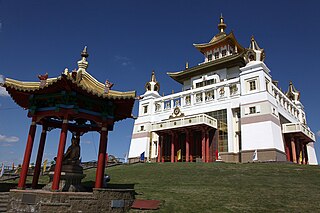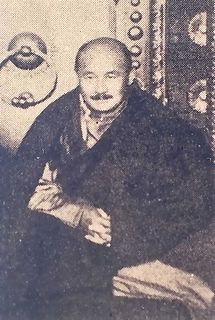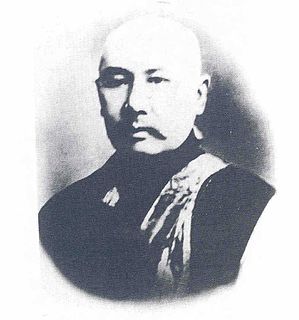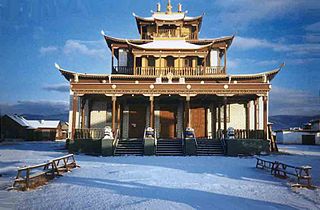
The Mongols are an East Asian ethnic group native to Mongolia, Inner Mongolia in China and the Buryatia Republic of the Russian Federation. The Mongols are the principal member of the large family of Mongolic peoples. The Oirats in Western Mongolia as well as the Buryats and Kalmyks of Russia are classified either as distinct ethno-linguistic groups or subgroups of Mongols.

The Kalmyks are a Mongolian ethnic group living mainly in Russia, whose ancestors migrated from Dzungaria. They created the Kalmyk Khanate from 1635 to 1779 in Russia's North Caucasus territory. Today they form a majority in Kalmykia, located in the Kalmyk Steppe, on the western shore of the Caspian Sea.

The Dzungar Khanate, also written as the Zunghar Khanate, was an Inner Asian khanate of Oirat Mongol origin. At its greatest extent, it covered an area from southern Siberia in the north to present-day Kyrgyzstan in the south, and from the Great Wall of China in the east to present-day Kazakhstan in the west. The core of the Dzungar Khanate is today part of northern Xinjiang, also called Dzungaria.

Oirats are the westernmost group of the Mongols whose ancestral home is in the Altai region of Siberia, Xinjiang and Western Mongolia.

The Kalmyk deportations of 1943, codename Operation Ulusy was the Soviet deportation of more than 93,000 people of Kalmyk nationality, and non-Kalmyk women with Kalmyk husbands, on 28–31 December 1943. Families and individuals were forcibly relocated in cattle wagons to special settlements for forced labor in Siberia. Kalmyk women married to non-Kalmyk men were exempted from the deportations. The government's official reason for the deportation was an accusation of Axis collaboration during World War II based on the approximately 5,000 Kalmyks who fought in the Nazi-affiliated Kalmykian Cavalry Corps. The government refused to acknowledge that more than 23,000 Kalmyks served in the Red Army and fought against Axis forces at the same time.

Kalmykia, officially the Republic of Kalmykia, is a republic and country of Russia located directly north of the North Caucasus in Eastern Europe. The republic is part of the Southern Federal District, and borders Dagestan to the south and Stavropol Krai to the southwest; Volgograd Oblast to the northwest and north and Astrakhan Oblast to the north and east; Rostov Oblast to the west and the Caspian Sea to the east. Kalmykia is the only region in Europe where Buddhism is the predominant religion.

The Kalmyk people are the only people of Europe whose national religion is Buddhism. In 2016, 53.4% of the population surveyed identified themselves as Buddhist. They live in Kalmykia, a federal subject of the Russian Federation located in southwestern Russia. The border faces Dagestan to the south, Stavropol Krai to the southwest, Rostov Oblast to the west, Volgograd Oblast to the northwest and Astrakhan Oblast to the east. The Caspian Sea borders Kalmykia to the southeast.

The Torghut, Chinese: 土尔扈特, "Guardsman" are one of the four major subgroups of the Four Oirats. The Torghut nobles traced its descent to the Keraite ruler Tooril; also many Torghuts descended from the Keraites.

Ja Lama was an adventurer and warlord of unknown birth and background who fought successive campaigns against the rule of the Qing dynasty in western Mongolia between 1890 and 1922. He claimed to be a Buddhist lama, though it is not clear whether he actually was one, as well as a grandson and later the reincarnation of Amursana, the Khoid-Oirat prince who led the last great Mongol uprising against the Qing in 1757. He was one of the commanders of Mongolian forces that liberated Khovd city from Qing control in 1912.

Lubsan Sharab Tepkin (1875–1941?) was a Buddhist priest of Kalmyk origin who was born in the Bokshirgankan aimak in the Salsk District of the Don Cossack Host sometime in 1875.

Menko Bormanzhinov was a Buddhist priest of Kalmyk origin who was born in the Bokshirgankan aimak in the Salsk District of the Don Cossack Host sometime in 1855.

Ivan Bultinovich Kitanov (1858-1926) was a Buddhist priest of Kalmyk origin who was born in the Beliavin aimak in the Salsk District of the Don Cossack Host.

Arkad Chubanov (1840–1894) was a Buddhist priest of Kalmyk origin who was born in the Ike Burul aimak in the Salsk District of the Don Cossack Host sometime in 1840.

Djimba Mikulinov was a Buddhist priest of Kalmyk origin who was most likely born in the Ike Burul aimak in the Salsk District of the Don Cossack Host. His dates of birth and death are unknown.

Pan-Mongolism is an irredentist idea that advocates cultural and political solidarity of Mongols. The proposed territory, called "Greater Mongolia", Also known as :which means "Whole Mongolia" usually includes the independent state of Mongolia, the Chinese regions of Inner Mongolia and Dzungaria, and the Russian republic of Buryatia. Sometimes the autonomous republic Tuva, the Altai Republic and parts of Zabaykalsky Krai and Irkutsk Oblast are included as well. As of 2006, all areas in Greater Mongolia except Mongolia have non-Mongol majorities.

The Four Oirat (Mongolian: Дөрвөн Ойрад, Dorben Oirad; also Oirads and formerly Eleuths, alternatively known as the Alliance of the Four Oirat Tribes or the Oirat Confederation, was the confederation of the Oirat tribes which marked the rise of the Western Mongols in Mongolian history.

Historically, Buddhism was incorporated into Siberia in the early 17th century. Buddhism is considered to be one of Russia's traditional religions and is legally a part of Russian historical heritage. Besides the historical monastic traditions of Buryatia, Tuva and Kalmykia, the religion of Buddhism is now spreading all over Russia, with many ethnic Russian converts.

The Kalmyk Khanate was an Oirat khanate on the Eurasian steppe. It extended over modern Kalmykia and surrounding areas in the North Caucasus, including Stavropol and Astrakhan. During their independence, the Kalmyks both raided and allied with Russia in turn, engaging in numerous military expeditions against the Crimean Tatars, the Ottoman Empire, neighboring Muslim tribes, and the highlanders of the North Caucasus. The Khanate was annexed by the Russian Empire in 1771.
Anti-Mongol sentiment has been prevalent throughout history, often perceiving the Mongols to be a barbaric and uncivilized people with a lack of intelligence or civilized culture.
Tsem Tulku Rinpoche was a recognised tulku of Kalmyk descent, an incarnate lama of the Gelug school of Tibetan Buddhism, and the founder and spiritual guide of Kechara House Buddhist Association with its headquarters in Malaysia.
















